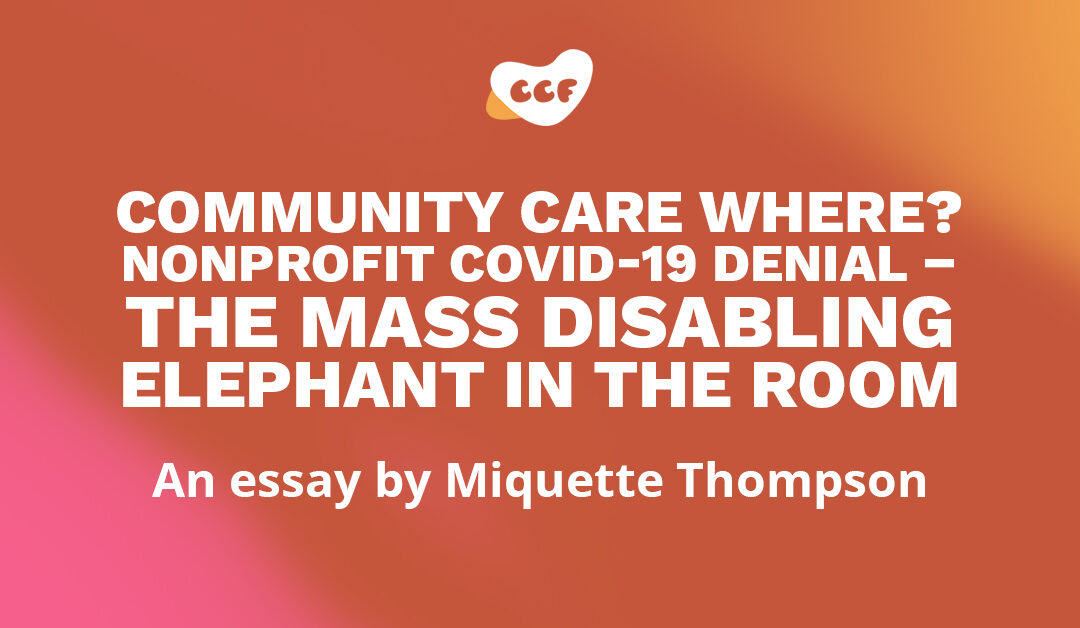By Miquette Thompson, Donor Organizer
…isn’t that why so many of us are here—to do the very hard work of tackling systemic issues in service to a more just and equitable world? Why are we ignoring something that has such widespread implications for our communities and movements?
Nonprofit leaders, does your organization speak of the pandemic in the past tense? No testing, masking, or vaccination policies to speak of? Back to all in-person everything, including those beloved happy hours, retreats, conferences, and gala events?
One more question: have you considered how COVID-19 minimization and denial will impact your organization’s ability to survive long-term, and how failure to adapt to the reality of the present moment is disabling and in some cases, even killing staff and supporters?
It’s not fun to think about. It contradicts the dominant “back to normal at all costs” and “keep producing and consuming no matter what” messaging we are receiving at all levels of society. It forces us to think about where we may have caused harm. It means that we need to create and advocate for systemic change around yet another issue.
But isn’t that why so many of us are here—to do the very hard work of tackling systemic issues in service to a more just and equitable world? Why are we ignoring something that has such widespread implications for our communities and movements?
Facing the Reality of a Changed World
It has been surreal to watch otherwise “progressive” nonprofit leaders who speak of equity and justice participate in collective denial of the ongoing threat COVID-19 poses to our work. It has been heartbreaking to see fundraisers I once respected participating in this denial. I am by no means the first to observe this schism between stated values and action–Leah Lakshmi Piepzna-Samarasinha, Raia Small, and others have written excellent pieces on this. In our sector, we talk at length about making data driven decisions—the data is here, it’s clear, and it’s being actively ignored. COVID-19 is significantly impacting cognitive and physical health for people across age groups.
As a fundraiser, I see obvious connections between COVID-19 prevention, donor capacity, and staff capacity. I’ve seen development teams struggle to stay afloat with a revolving door of sick staff experiencing impacts from repeat infections, from brain fog to cardiovascular issues. I have had direct experience seeing increases in COVID-related medical costs impact the ability of donors to both give and engage actively with organizations they love. I have watched as colleagues struggle silently to maintain their baseline health after repeat infections from the workplace, with no support from their employers who continue to push them mercilessly into “back to normal.”
The hard truth of this moment is that there is no “normal” to return to.
We had an opportunity to radically reimagine and restructure ways of connecting with and caring for each other when COVID-19 emerged. We can still recommit to this work. I want to push myself and my colleagues to develop creative ways to safely engage with donors and each other, because community care is not an abstract concept or a trite expression–it’s love and justice in action. For this reason, I will not stop advocating for better education around COVID mitigations among the organizations I work with, and within my own, whenever possible.
Making Care, Love & Justice Actionable
How do we begin to do better? This list is not exhaustive, but here are some places to start:
- Acknowledge that COVID-19 transmission is airborne and plan events and office layouts accordingly. People’s CDC and Clean Air Club have some great resources on how to help keep the air clean to reduce transmission. Can’t afford air purifiers? Try building Corsi-Rosenthal boxes–it can be a great team building exercise!
- If your organization must host in-person events, consider purchasing a set of air purifiers and a CO2 monitor for use at your organization’s events, creating clear policies and guidelines for use. Include researching HVAC and airflow into event venue research. Monitor wastewater levels in your region where possible to avoid hosting events during a surge.
- Provide or subsidize quality N95s at the office as part of employee wellness in favor of baggy blue surgical masks or cloth masks. COVID-19 is airborne, so while hand hygiene is great for some things, providing an endless stream of hand sanitizer and no masks is a senseless approach to mitigating COVID-19. Consider providing mask fit testing guides for employees, as we know that masks work best when they fit.
- No more magical thinking–be honest about the risks you’re asking employees to take, and do not ostracize those who do not want to risk a COVID-19 infection or force them to request accommodation. Group meals are not inclusive activities for people who can’t be unmasked around people outside of their household. COVID-19 does not disappear when we eat a meal or are outside. Outdoor gatherings are not inherently risk free. Provide alternate options for people who cannot risk infection to connect with one another, and at minimum, do not penalize employees who are unable to participate in unmasked social gatherings.
- Accept that in-person activities are not inherently “better” than virtual activities. Not only is this line of thinking ableist, it routinely results in organizations deprioritizing the experience of virtual event attendees in favor of people attending in-person. I have been to in-person events that were extremely transactional and not engaging at all, and have also attended deeply meaningful and engaging virtual events. Events are as inclusive and engaging as we choose to make them, regardless of setting!
- Normalize masks and treat them like any other piece of assistive technology. You wouldn’t ask someone in a wheelchair to stand up or a person to hide their cane or remove their glasses for a photo, therefore it is inappropriate and ableist to ask someone to remove their mask for a photo or because you’d prefer they not wear one. Call it out if you see masked people deliberately being cropped out of your organization’s photos.
- Commit to building an organizational culture that treats COVID infection as preventable and not inevitable by talking about, normalizing and utilizing the many layers and types of protection that are available to us. Sustain this internal culture through reminders that COVID-19 is not just a “mild cold” but a complex pathogen that has major long-term effects, and that we have the power to protect each other.
- Start or continue learning about disability justice. The work of Sins Invalid, Imani Barbarin, and Alice Wong are great, accessible places to start. Like other forms of bias, ableism can be internalized and challenging to unlearn, but must be addressed if we are truly working toward collective liberation.
It is never too late to learn, adapt, and change behavior. As I write this article, the eight wave and second biggest surge of COVID-19 since the start of the pandemic is approaching its peak. It is my sincere and heartfelt hope that more people within the nonprofit sector will begin to embrace real, effective COVID-19 mitigations for the health and wellbeing of themselves and their communities.

Miquette Thompson
Miquette Thompson (she/her) has been working within the nonprofit sector for nearly two decades, has been liberating capital in fund development roles since 2010, and has been a part of social justice movement work since childhood. She resides on unceded Coast Pomo land in Northern California, and is an active grassroots organizer in her community. To learn more about Miquette and read more of her writing, visit www.miquettethompson.com.


Thank you for articulating this so perfectly!
I am in Canada, where I think there is less denial than in the US. But only a matter of degree. My provincial government and municipal public health continue to promote vaccination and provide it for free. But they don’t promote masking, don’t track infection rates, don’t promote wastewater results, etc. They have largely resumed in person meetings.
Great article and a reminder to me to ensure that we take an equitable, science informed approach. I’m also in Canada and so grateful that our Public Health Unit continues to publish a weekly COVID and Respiratory Risk Index with outbreak information per sector. At our non-profit we continue all of the procedures implemented in March 2020, and to remind everyone about handwashing, monitoring symptoms, the limitations of testing with new variants and to remember that it’s important to know the gut and respiratory symptoms, to monitor yourself, and to stay home until symptoms subside. We are so proud of all of our staff for maintaining all of the precautions we implemented and preventing workplace transmissions. Some of my grounding in infection prevention is rooted in years of experience supporting people with compromised immune systems and reducing the transmission of air and blood borne infections. I know we can always do better.
I seriously can’t thank you enough for this article! You said all the words I couldn’t figure out how to say.